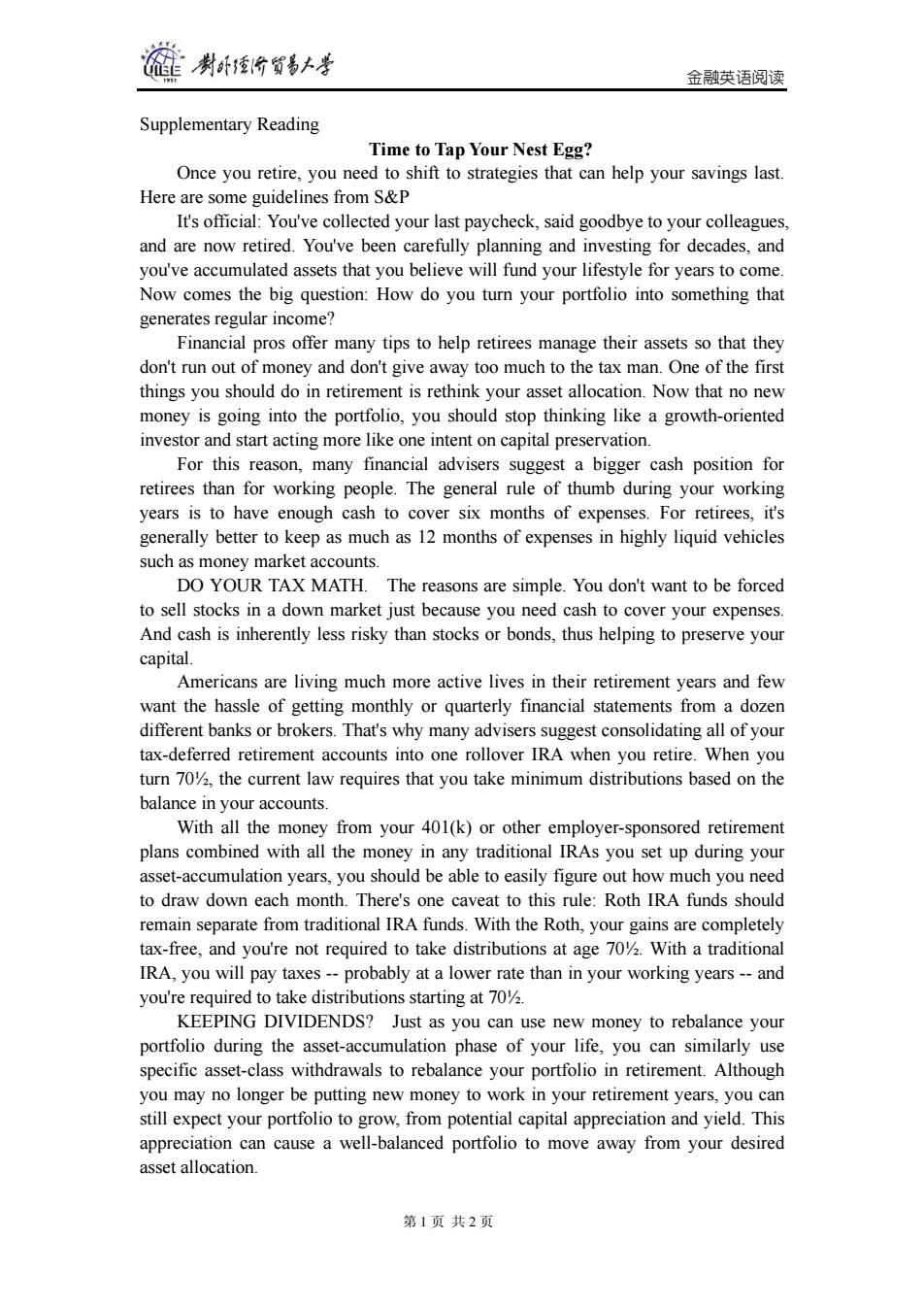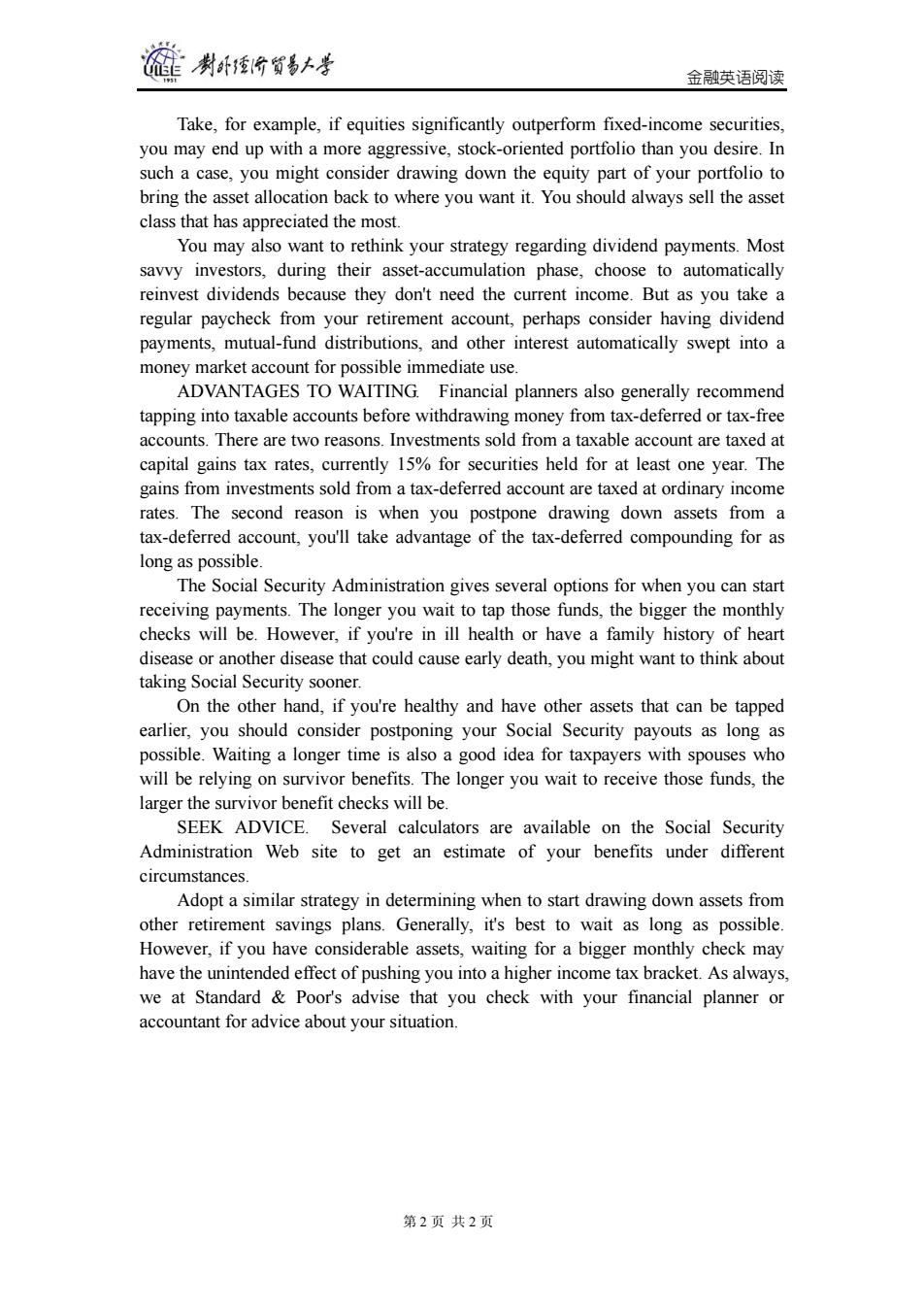
制卧台贸易上兰 金融英语阅读 Supplementary Reading Time to Tap Your Nest Egg? Once you retire,you need to shift to strategies that can help your savings last. Here are some guidelines from S&P It's official:You've collected your last paycheck,said goodbye to your colleagues, and are now retired.You've been carefully planning and investing for decades,and you've accumulated assets that you believe will fund your lifestyle for years to come. Now comes the big question:How do you turn your portfolio into something that generates regular income? Financial pros offer many tips to help retirees manage their assets so that they don't run out of money and don't give away too much to the tax man.One of the first things you should do in retirement is rethink your asset allocation.Now that no new money is going into the portfolio,you should stop thinking like a growth-oriented investor and start acting more like one intent on capital preservation. For this reason,many financial advisers suggest a bigger cash position for retirees than for working people.The general rule of thumb during your working years is to have enough cash to cover six months of expenses.For retirees,it's generally better to keep as much as 12 months of expenses in highly liquid vehicles such as money market accounts. DO YOUR TAX MATH.The reasons are simple.You don't want to be forced to sell stocks in a down market just because you need cash to cover your expenses. And cash is inherently less risky than stocks or bonds,thus helping to preserve your capital. Americans are living much more active lives in their retirement years and few want the hassle of getting monthly or quarterly financial statements from a dozen different banks or brokers.That's why many advisers suggest consolidating all of your tax-deferred retirement accounts into one rollover IRA when you retire.When you turn 70%,the current law requires that you take minimum distributions based on the balance in your accounts. With all the money from your 401(k)or other employer-sponsored retirement plans combined with all the money in any traditional IRAs you set up during your asset-accumulation years,you should be able to easily figure out how much you need to draw down each month.There's one caveat to this rule:Roth IRA funds should remain separate from traditional IRA funds.With the Roth,your gains are completely tax-free,and you're not required to take distributions at age 70%.With a traditional IRA,you will pay taxes--probably at a lower rate than in your working years--and you're required to take distributions starting at 70%2. KEEPING DIVIDENDS?Just as you can use new money to rebalance your portfolio during the asset-accumulation phase of your life,you can similarly use specific asset-class withdrawals to rebalance your portfolio in retirement.Although you may no longer be putting new money to work in your retirement years,you can still expect your portfolio to grow,from potential capital appreciation and yield.This appreciation can cause a well-balanced portfolio to move away from your desired asset allocation. 第1页共2页
金融英语阅读 Supplementary Reading Time to Tap Your Nest Egg? Once you retire, you need to shift to strategies that can help your savings last. Here are some guidelines from S&P It's official: You've collected your last paycheck, said goodbye to your colleagues, and are now retired. You've been carefully planning and investing for decades, and you've accumulated assets that you believe will fund your lifestyle for years to come. Now comes the big question: How do you turn your portfolio into something that generates regular income? Financial pros offer many tips to help retirees manage their assets so that they don't run out of money and don't give away too much to the tax man. One of the first things you should do in retirement is rethink your asset allocation. Now that no new money is going into the portfolio, you should stop thinking like a growth-oriented investor and start acting more like one intent on capital preservation. For this reason, many financial advisers suggest a bigger cash position for retirees than for working people. The general rule of thumb during your working years is to have enough cash to cover six months of expenses. For retirees, it's generally better to keep as much as 12 months of expenses in highly liquid vehicles such as money market accounts. DO YOUR TAX MATH. The reasons are simple. You don't want to be forced to sell stocks in a down market just because you need cash to cover your expenses. And cash is inherently less risky than stocks or bonds, thus helping to preserve your capital. Americans are living much more active lives in their retirement years and few want the hassle of getting monthly or quarterly financial statements from a dozen different banks or brokers. That's why many advisers suggest consolidating all of your tax-deferred retirement accounts into one rollover IRA when you retire. When you turn 70½, the current law requires that you take minimum distributions based on the balance in your accounts. With all the money from your 401(k) or other employer-sponsored retirement plans combined with all the money in any traditional IRAs you set up during your asset-accumulation years, you should be able to easily figure out how much you need to draw down each month. There's one caveat to this rule: Roth IRA funds should remain separate from traditional IRA funds. With the Roth, your gains are completely tax-free, and you're not required to take distributions at age 70½. With a traditional IRA, you will pay taxes -- probably at a lower rate than in your working years -- and you're required to take distributions starting at 70½. KEEPING DIVIDENDS? Just as you can use new money to rebalance your portfolio during the asset-accumulation phase of your life, you can similarly use specific asset-class withdrawals to rebalance your portfolio in retirement. Although you may no longer be putting new money to work in your retirement years, you can still expect your portfolio to grow, from potential capital appreciation and yield. This appreciation can cause a well-balanced portfolio to move away from your desired asset allocation. 第 1 页 共 2 页

制卧台贸易上兰 金融英语阅读 Take,for example,if equities significantly outperform fixed-income securities, you may end up with a more aggressive,stock-oriented portfolio than you desire.In such a case,you might consider drawing down the equity part of your portfolio to bring the asset allocation back to where you want it.You should always sell the asset class that has appreciated the most. You may also want to rethink your strategy regarding dividend payments.Most savvy investors,during their asset-accumulation phase,choose to automatically reinvest dividends because they don't need the current income.But as you take a regular paycheck from your retirement account,perhaps consider having dividend payments,mutual-fund distributions,and other interest automatically swept into a money market account for possible immediate use. ADVANTAGES TO WAITING.Financial planners also generally recommend tapping into taxable accounts before withdrawing money from tax-deferred or tax-free accounts.There are two reasons.Investments sold from a taxable account are taxed at capital gains tax rates,currently 15%for securities held for at least one year.The gains from investments sold from a tax-deferred account are taxed at ordinary income rates.The second reason is when you postpone drawing down assets from a tax-deferred account,you'll take advantage of the tax-deferred compounding for as long as possible. The Social Security Administration gives several options for when you can start receiving payments.The longer you wait to tap those funds,the bigger the monthly checks will be.However,if you're in ill health or have a family history of heart disease or another disease that could cause early death,you might want to think about taking Social Security sooner. On the other hand,if you're healthy and have other assets that can be tapped earlier,you should consider postponing your Social Security payouts as long as possible.Waiting a longer time is also a good idea for taxpayers with spouses who will be relying on survivor benefits.The longer you wait to receive those funds,the larger the survivor benefit checks will be. SEEK ADVICE.Several calculators are available on the Social Security Administration Web site to get an estimate of your benefits under different circumstances. Adopt a similar strategy in determining when to start drawing down assets from other retirement savings plans.Generally,it's best to wait as long as possible. However,if you have considerable assets,waiting for a bigger monthly check may have the unintended effect of pushing you into a higher income tax bracket.As always, we at Standard Poor's advise that you check with your financial planner or accountant for advice about your situation. 第2页共2页
金融英语阅读 Take, for example, if equities significantly outperform fixed-income securities, you may end up with a more aggressive, stock-oriented portfolio than you desire. In such a case, you might consider drawing down the equity part of your portfolio to bring the asset allocation back to where you want it. You should always sell the asset class that has appreciated the most. You may also want to rethink your strategy regarding dividend payments. Most savvy investors, during their asset-accumulation phase, choose to automatically reinvest dividends because they don't need the current income. But as you take a regular paycheck from your retirement account, perhaps consider having dividend payments, mutual-fund distributions, and other interest automatically swept into a money market account for possible immediate use. ADVANTAGES TO WAITING. Financial planners also generally recommend tapping into taxable accounts before withdrawing money from tax-deferred or tax-free accounts. There are two reasons. Investments sold from a taxable account are taxed at capital gains tax rates, currently 15% for securities held for at least one year. The gains from investments sold from a tax-deferred account are taxed at ordinary income rates. The second reason is when you postpone drawing down assets from a tax-deferred account, you'll take advantage of the tax-deferred compounding for as long as possible. The Social Security Administration gives several options for when you can start receiving payments. The longer you wait to tap those funds, the bigger the monthly checks will be. However, if you're in ill health or have a family history of heart disease or another disease that could cause early death, you might want to think about taking Social Security sooner. On the other hand, if you're healthy and have other assets that can be tapped earlier, you should consider postponing your Social Security payouts as long as possible. Waiting a longer time is also a good idea for taxpayers with spouses who will be relying on survivor benefits. The longer you wait to receive those funds, the larger the survivor benefit checks will be. SEEK ADVICE. Several calculators are available on the Social Security Administration Web site to get an estimate of your benefits under different circumstances. Adopt a similar strategy in determining when to start drawing down assets from other retirement savings plans. Generally, it's best to wait as long as possible. However, if you have considerable assets, waiting for a bigger monthly check may have the unintended effect of pushing you into a higher income tax bracket. As always, we at Standard & Poor's advise that you check with your financial planner or accountant for advice about your situation. 第 2 页 共 2 页